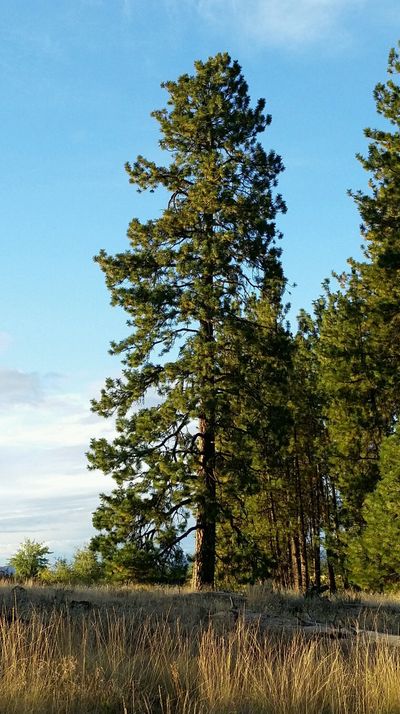Landmarks: Ponderosa pine 250 years old

“Trees are your best antiques.”
– Alexander Smith, Scottish poet
There is a cluster of ponderosa pine trees standing out in a field north and east of Deep Creek Falls. While it looks pretty similar to hundreds of others that dot the landscape of Eastern Washington, this one contains something special.
About a dozen or so years ago forestry consultant Don Hyslop was mapping out a land stewardship program for property near Seven Mile Road when his trained eye noticed one special tree in the grouping. It wasn’t the tallest tree there, but the observable characteristics of the tree suggested to him that this was an old tree. The self-confessed tree man with a special love for big trees studied the round-topped tree closer.
He first examined a suppressed tree that practically grew out of the same spot on the basalt in that place in the forested wetland, but because of a variety of factors was overshadowed by its larger companion. It was obvious to Hyslop that the two trees grew at the same time and were the same age. Best management practices indicated the smaller tree should be removed to give better survival chances for the dominant tree.
What Hyslop did then was to count rings on the trunk of the downed suppressed tree, which he was then able to date back to the 1760s or 1770s – nearly 250 years ago. The old intact tree isn’t the biggest or widest or perhaps most dramatic of this native species, at perhaps 115 feet tall with a trunk at chest height measuring just short of 4 feet in diameter. A much younger tree standing just next to it is clearly taller.
But what Hyslop recognized was that this tree is a special kind of landmark, having stood in that spot since before America was America. It was just a sapling in 1770 when the Boston Massacre, recognized as the first battle of the American Revolution, took place and when William Clark of the famed 1804-06 Lewis and Clark Expedition was born. As the tree continued to grow, events still to come were the Declaration of Independence, the Civil War, statehood for Washington (1889), the Great Depression, both world wars and the first footsteps on the moon.
It – like so many other ponderosas – is valuable for its age and dignity and for being silent sentinels to the passage of time, said Patrish Brady, executive director of Spokane Ponderosa ( SpokanePonderosa.com), an organization dedicated to preserving and revitalizing ponderosas in Spokane County. Old growth trees especially, but ponderosas in general, serve such an important role in so many other ways, she said, that she wonders at how they can be overlooked or taken for granted as much as they are.
In addition to being native to the area, she said, they are drought tolerant, fire-resistant (protected by thick bark) and most effective in absorbing pollutants and carbon dioxide. Their roots are especially good at stabilizing soil, Brady added, which is why her organization is working with Finch Arboretum to plant new ponderosas to help stop the erosion taking place along the creek bank there.
This past spring – working with volunteers from the Boy Scouts, Fairchild Air Force Base and others – they put in 12,000 seedlings in various locations in and around Spokane, including 4,200 along the Parksmith Interchange of the North Spokane Corridor of Highway 395. She also took seedlings to Hamblen Elementary School this past year and talked about them with kindergartners there, after which each child planted a little tree in the natural area adjacent to the school.
And in April, the ponderosa pine became the official tree of the city of Spokane.
Among the ponderosas that stand in Eastern Washington are other unbeknown centuries-old ones like the one Don Hyslop has identified. But there are fewer and fewer of them, Brady said, as they are routinely cut down for lumber or replaced in urban and suburban areas with ornamental species. And she added:
“But really, ponderosas are the perfect tree for this area. It’s time to love them again.”